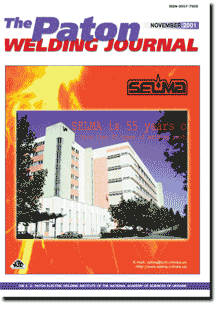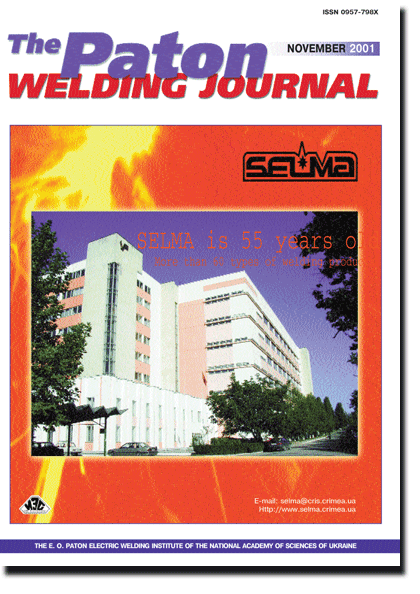

| SCIENTIFIC AND TECHNICAL | |
| Makhnenko V.I., But V.S., Velikoivanenko E.A., Rozynka G.F. and Pivtorak N.I. Mathematical modelling of pitting defects in active oil and gas pipelines and development of a numerical method for estimation of permissible parameters of arc welding repair of defects. | 2 |
| The article considers the possibility of welding repair of pitting corrosion defects 12...20 mm in diameter on the outside surface of walls of a main oil pipeline of steel 17G1S without interruption of its operation. Described is the general procedure for selection of parameters of arc welding repair of a defect, which eliminate burn-through and fracture in the welding zone caused by the mechanism of high-temperature plastic instability and cold (hydrogen) cracking. | |
| Kalensky V.K., Chernyak Ya.P., Vasiliev V.G. and Solomijchuk T.G.
Heat input influence on formation of tears in high-carbon steel building-up with austenitic wires. | 9 |
| Multilayer building-up of worn surfaces of girder tram rails with austenitic wires of PP-06Kh15G15N2MF type is used to demonstrate that deposition of the first bead by one arc with 28-30 kJ/cm heat input prevents tears formation in the HAZ metal of difficult-to-weld high-carbon steel M-76. | |
| Ryabov V.R., Muravejnik A.N., Budnik V.P., Bondarev Andr.A.,
Monnin M.M., Polkin I.S., Konkevich V.Yu. and Trubkina E.M. Investigation of weldability of dispersion-strengthened Al/SiC composite material. | 13 |
| The effect of non-stationary heat sources in electron beam, laser and argon-arc welding on structural changes the matrix, behaviour and decomposition of strengthening particles in cast alumocomposite with dispersed SiC ceramic particles was examined. The technology of argon-arc welding of AMg5/12 vol.% SiC composite material is suggested. | |
| Zamkov V.N., Velikoivanenko E.A., Sabokar V.K. and Vrzhizhevsky
E.L. Selection of temperature of preheating of gamma-titanium aluminide in electron beam welding. | 17 |
| Development elasto-plastic strains in welding heating and cooling of samples of gamma-titanium aluminide alloy has been analysed using calculation methods. The level of residual longitudinal stresses in the alloy plates 5-17 mm thick in EBW, depending upon the temperatures of preheating and annealing of welded joints after welding, has been determined. It has been established that prevention of formation of cold cracks in the 47XD alloy weld made by single-pass EBW on metal up to 17 mm thick is provided by preheating the samples to 400-500 oC and annealing of welded joints within a temperature range of 800-900 oC for 10-15 min. | |
| Shlepakov V.N. and Naumejko S.M. Effect of surface tension of welding slags of salt-oxide system on characteristics of welding-technological properties of self-shielding flux-cored wire. | 21 |
| Dependence of surface tension of slag of the salt-oxide BaF2-LiF-MgO system on its composition and temperature was investigated. The effect of surface tension on the welding-technological properties of the flux-cored wires in welding in various spatial positions is considered. | |
| Khaskin V.Yu., Shelyagin V.D., Garashchuk V.P., Sidorets V.N.,
Sakharnov A.V. and Goncharenko E.I. Laser butt welding with high-frequency heating of weld edges. | 24 |
| Investigated was the combined effect on steel by laser radiation and high-frequency heating in butt welding. Concurrent high-frequency heating to a temperature on the sample surface equal to 1100-1200 oC was established to cause an increase of 1.5 times either in the penetration depth or in the welding process speed. Geometry of the welds is close to that typical for laser welding, although the welds are different in structure (the weld and HAZ metal contains no quenching structures characteristic of laser welding, and values of hardness differ to a lesser degree from those of the base metal). | |
| INDUSTRIAL | |
| Lebedev V.K. and Pismenny A.A. Power systems of resistance welding machines. | 28 |
| Power systems of resistance welding machines are analysed, including single-phase machines of commercial frequency and three-phase machines with converters of frequency and phase number. Qualitative comparison of seven power systems is performed in terms of their technological properties, influence of disturbances on the joint quality, electrode wear, as well as power characteristics. | |
| Efimenko N.G. and Kalin N.A. Calculation of optimum content of carbon and manganese in electrode ilmenite-type coatings. | 33 |
| Use of carbon in the composition of the ferro-alloy, in particular cast iron, as a deoxidizer in welding ilmenite-type electrodes is suggested. The method of calculation of equilibrium content of carbon and manganese in the deposited metal has been developed that makes it possible to determine the maximum admissible amount of carbon, added with a cast iron powder into the electrode coatings at different shares of ilmenite, FeMn and [Mn]. | |
| Korotynsky A.E. Functional and test diagnostics of welding equipment. | 36 |
| The paper deals with the problems of orginizing a diagnostic support of welding equipment. Procedures of functional diagnostics of inverter and resonance arc welding sources are described. It is shown that the resonance arc welding sources require test temperature diagnostics of the capacitance reactor condition. Procedures with a partial and complete diagnostics of the latter are presented. Also considered is a scheme of the resonance source with a functional-test diagnostics. | |
| Matvienko V.N., Stepnov K.K., Ivanov V.P., Zavarika N.G.,
Oldakovsky A.I. and Ermolov V.P. Mastering the technology for manufacture of cold-rolled alloyed hard-facing strip at the OJSC "Ilyich Mariupol Metallurgical Works". | 40 |
| Described are peculiarities of development of composition and manufacture of cold-rolled alloyed strip at the Open Joint-Stock Company "Ilyich MMW", intended for deposition of a wear-resistant metal layer by the electric-arc hard- facing method to repair and harden parts of rolling and metallurgical facilities. | |
| BRIEF INFORMATION | |
| Mikheev P.P. and Vojtenko O.V. Role of stress concentration reduction at high-frequency peening for fatigue resistance increase in welded joints. | 42 |
| Experimental values of stress concentration factor (SCF), determined using polarization-optical (photoelasticity) method, are compared with estimated values, determined by measurement of parameters of fillet welds of T-joints in initial state and after high-frequency peening. The relation between the SCF reduction under the action of the high-frequency peening and increase in the fatigue resistance of the welded joints is shown. | |
| Tsybulkin G.A. Robust digital sensor for arc welding | 44 |
| Modification of a digital arc sensor designed for a current estimation of the electrode deviation from the axial line of the joint being welded is suggested. The sensitivity of the sensor to some parametric disturbances of the welding process is reduced significantly due to the mounting of an additional digital unit. | |
(You are viewing the simplified file contents)
The cost of subscription/purchase order journals or individual articles
| Journal/Currency | Annual Set | 1 issue printed |
1 issue |
one article |
| TPWJ/USD | 384 $ | 32 $ | 26 $ | 13 $ |
| TPWJ/EUR | 348 € | 29 € | 24 € | 12 € |
| TPWJ/UAH | 7200 UAH | 600 UAH | 600 UAH | 280 UAH |
| AS/UAH | 1800 UAH | 300 UAH | 300 UAH | 150 UAH |
| AS/USD | 192 $ | 32 $ | 26 $ | 13 $ |
| AS/EUR | 180 € | 30 € | 25 € | 12 € |
| SEM/UAH | 1200 UAH | 300 UAH | 300 UAH | 150 UAH |
| SEM/USD | 128 $ | 32 $ | 26 $ | 13 $ |
| SEM/EUR | 120 € | 30 € | 25 € | 12 € |
| TDNK/UAH | 1200 UAH | 300 UAH | 300 UAH | 150 UAH |
| TDNK/USD | 128 $ | 32 $ | 26 $ | 13 $ |
| TDNK/EUR | 120 € | 30 € | 25 € | 15 € |
AS = «Automatic Welding» - 6 issues per year;
TPWJ = «PATON WELDING JOURNAL» - 12 issues per year;
SEM = «Electrometallurgy Today» - 4 issues per year;
TDNK = «Technical Diagnostics and Non-Destructive Testing» - 4 issues per year.


